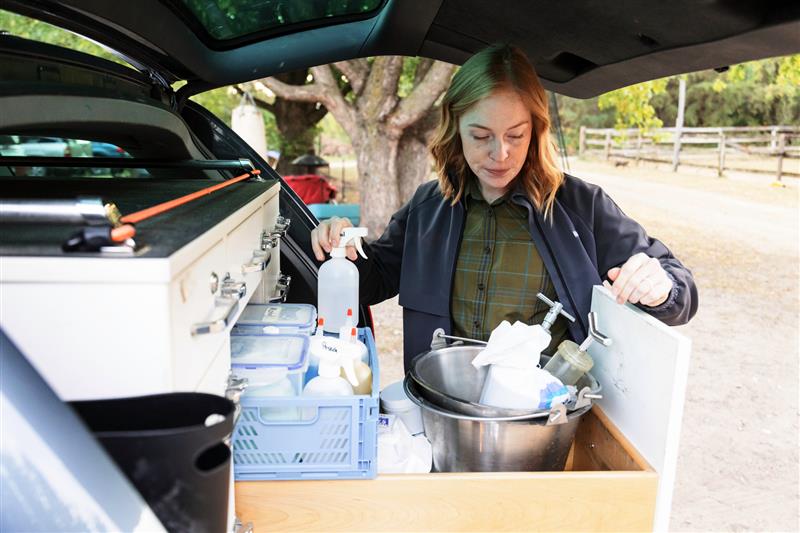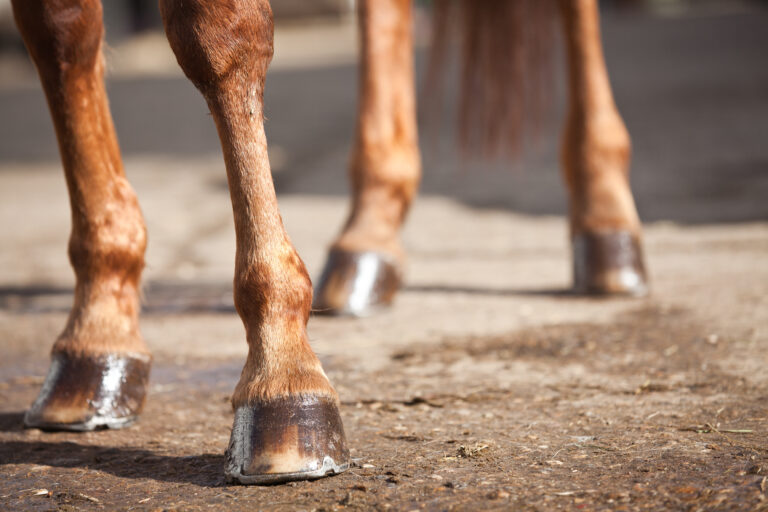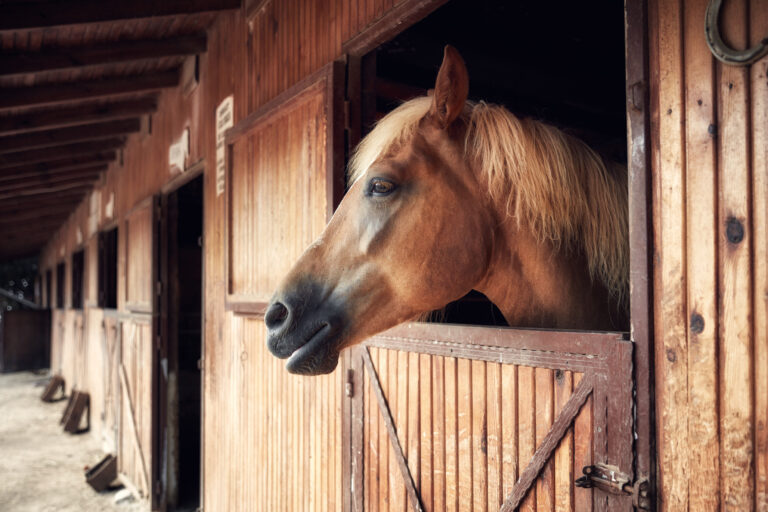
When Hannah R. Leventhal, DVM, MS, DACVIM (LAIM), worked as an ambulatory veterinarian on the West Coast, she carried a case of Lysol and permeable disposable blue gowns or white suits. Pigeon fever was rampant, and she worried about spreading it from one farm to another.
“We would Lysol ourselves off in between cases and made sure to spray everything as best we could,” says Leventhal, an FEI Permitted Treating Veterinarian and an assistant teaching professor of Equine Emergency Medicine at the University of Missouri. “Spreading pigeon fever unintentionally was my biggest fear.”
Mobility is both the biggest asset and the biggest liability for ambulatory equine practitioners. Mobile practitioners are critical to bringing routine, preventive, and emergency care to horse owners’ barn doors. At the same time, seeing horses at multiple facilities within the same day creates an opportunity for disease transmission.
A 2021 American Association of Equine Practitioners (AAEP) survey revealed the average ambulatory vet visits four to six premises daily, potentially contacting 15-30 horses—each representing a transmission opportunity.
“Ambulatory veterinarians who travel from farm to farm have the potential for encountering a horse with an infectious disease and, as such, have the ability to be a fomite, spreading disease from premises to premises,” says Katie Flynn, BVMS, the senior staff veterinarian at US Equestrian. “A biosecurity plan is critical to preventing this spread. For ambulatory veterinarians, there are specific practices during the farm call to minimize transmission risk.”
Josie Traub-Dargatz, DVM, MS, DACVIM, notes that the AAEP includes disease transmission prevention as a core practice tenant. Since 2016, the AAEP has recommended that all equine practices—solo or group—have a biosecurity plan that all practice personnel actively administer and adhere to. In 2022, the AAEP developed a position statement on biosecurity for equine practitioners.
“Based on high-profile disease outbreaks, the equine industry has become more aware of the need for infection control beyond vaccination,” says Traub-Dargatz, a professor emeritus in the Department of Clinical Sciences at Colorado State University. “With this heightened awareness within the industry, horse owners should be able to ask their veterinarian what protocols their practice uses to prevent disease spread.”
The tricky part about designing a biosecurity plan is that no singular plan fits all scenarios. Farms and venues have varying risk and risk aversion levels, which requires a different plan for those stops.
“I know farms that are very risk averse, and they provide their visiting veterinarian with dedicated coveralls and boots that remain on-site and are laundered on-site after each visit,” Traub-Dargatz says. “It’s important to be able to have a routine level of precautions that can be scaled up based on situations where there is a heightened concern.”
Sometimes, even following best practices and doing all the “right” things isn’t enough to prevent the spread of an infectious disease. However, having a biosecurity plan in place can limit the risk and help you sleep better at night. Here, experts share advice on creating a practical biosecurity plan for your practice.
Creating and Updating Your Equine Biosecurity Plan
A biosecurity plan for an ambulatory practitioner is like that implemented at a veterinary clinic. It begins with establishing a protocol with step-by-step actions for facility entry, animal contact, and facility exit, says Nathaniel “Nat” White, DVM, DACVS, a professor emeritus of Equine Surgery at Virginia Tech’s Marion duPont Scott Equine Medical Center and the director and administrative consultant for the Equine Disease Communication Center (EDCC).
“A biosecurity protocol should include procedures to leave the facility to prevent spread to the next appointment,” he says. “Plan contact with horses for routine examinations and treatments, and how to approach a horse with a suspect infectious disease.”
Flynn says a thorough biosecurity plan includes five key areas:
- Purchasing personnel protective equipment (PPE). Appropriate PPE, such as coveralls and boots, should be available and used for each visit. In the event of a potential infectious disease case, discard or launder your coveralls. Clean organic material from boots, and spray them with disinfectant.
- Practicing on-farm hand hygiene. The ambulatory vehicle should carry hand sanitizer at all times. Hand sanitization should be practiced in a suspected infectious disease case. However, using hand sanitizer before and after handling apparently healthy horses is a good standard practice, as these horses could be asymptomatically shedding pathogens.
- Using cleaning and disinfection supplies. Ideally, the ambulatory vehicle carries a disinfectant that has a label claim for effectiveness against common equine pathogens.
- Following equipment cleaning and disinfection protocols. Best biosecurity practices for an ambulatory practitioner include cleaning and disinfecting equipment after each use, especially in suspected infectious disease situations.
- Identifying potential infectious disease cases. Proper triaging and scheduling of potential infectious disease cases reduces the risk of spreading pathogens to multiple premises. When possible, schedule suspect cases of infectious diseases for the end of the day. When a farm call turns into an unplanned infectious disease suspect, protocols should be in place to take necessary steps to prevent the spread.
“Scheduling is really important,” Leventhal says. “It is important to schedule routine and elective appointments in a way that makes sense geographically so you’re not wasting time. But think about keeping the strangles barn or potential strangles for the end of the day, so you have time to clean everything thoroughly before the next visit.”
In addition to scheduling sick horse visits strategically, build in 10-15 minutes between routine stops to allow time for cleaning equipment and handwashing. Vehicles themselves can potentially serve as vectors for spreading pathogens.
“I think a lot of people tend to forget about the truck itself,” Leventhal says. “Your vehicle could inadvertently carry things as well, and disinfecting should be part of your biosecurity plan.”
Overcoming the Barriers of Creating Equine Biosecurity Plans
Ambulatory practices are busy, and emergency calls can quickly derail an entire day. Finding time to create a biosecurity plan, review, and update existing infection control protocols takes time.
“Practitioners are challenged to get through all their calls on any given day, but it is important to use good hygiene practices to protect their patients,” Traub-Dargatz says. “You have to get over the idea that skipping basic hygiene practices is OK because that’s how you’ve done things in the past.”
In addition to the time crunch, some equine veterinarians feel they lack the expertise to create a biosecurity plan, according to survey results shared by White. The AAEP, EDCC, US Equestrian, and universities have extensive resources available to help practitioners implement and update biosecurity plans. Ambulatory veterinarians who have developed biosecurity plans for their practices also share their experiences with peers at AAEP conferences and other events.
“The AAEP General Guideline for Biosecurity guides equine practitioners in the development of a biosecurity plan for their clients that was updated in 2022 with several valuable links to additional resources,” Traub-Dargatz says.
Creating a culture that values biosecurity is essential for practices with multiple veterinarians or support staff. Regular team training sessions, including simulated disease outbreak scenarios, help maintain awareness and preparedness. These sessions can identify protocol weaknesses before they lead to actual disease transmission events.
It is also important to incorporate biosecurity metrics into performance reviews and recognize team members who consistently demonstrate excellent protocols. Instituting a no-blame reporting system for biosecurity lapses or close calls creates opportunities for learning to reduce future risks.
As digital tools continue to advance and become more readily available, they can be leveraged as part of a practice’s biosecurity protocol. Mobile apps and practice management software can include biosecurity fields that each veterinarian must fill out for each visit. RFID tags that can record when equipment is used and cleaned, automated client notification systems for disease alerts, and digital health certificates are all tools you can incorporate into your practice so a biosecurity plan becomes routine and easy to follow.
Involve Horse Owners in Your Planning
You’re out making scheduled visits when a client calls concerned about their horse. Leventhal recommends asking about the horse’s vaccination status, the health status of other horses on-site, and recent travel history.
“It is time-consuming, and those are questions you’re going to ask on-site, but those are important questions to ask off the bat,” she says. “Especially if they tell me the horse went to a show, and I’d heard about sick horses there, or if another horse at the facility has a fever, nasal discharge, or swelling.”
Getting horse and facility owners to take active roles in biosecurity planning can also be challenging. White shared survey results that found when equine veterinarians were asked what barriers they encountered when attempting to create biosecurity plans, responses included clients not wanting to pay for a plan.
“Include the biosecurity plan as part of the overall health program with appropriate compensation for the required time to set up a plan,” he suggests. “Educate the client by creating an example of the cost-savings a plan would provide if there was an infectious disease outbreak at the farm or stable.”
He adds that creating a list of what the owner should do in response to a horse with a suspected infectious disease should be part of the biosecurity plan. The Equine Disease Communication Center published, “What Horse Owners Should Do During the First 30 Minutes of a Suspected Infectious Disease Outbreak,” a printable or emailable PDF that veterinarians can give to clients. It highlights step-by-step instructions for handling a sick horse.
Plan for the Unexpected
Competitions and events have the potential to be superspreaders. For large events, horses potentially come together from all over the world, across the country and state lines. Even smaller regional or local events carry risks of disease spread.
Depending on the event, a veterinarian might be on staff to monitor for potential disease outbreaks. In emergencies, you might be called in to support disease control efforts at larger events or called out to see a client with a sick horse at a local event. In either case, being prepared to identify exposure and limit the risk of spread is essential.
“If you’re called to an event for a suspect infectious disease case, precautions should be taken to limit exposure and spread,” Flynn says.
She recommended the following precautions:
- Isolate the potential infectious disease case, and perform necessary sampling for diagnostic testing.
- Use PPE when handling a potential infectious disease case. At a minimum, use designated coveralls, disinfect footwear, and wash hands after handling the horse.
- Identify and monitor potentially exposed horses twice a day by taking and recording temperature while awaiting results.
“It would be optimal to know what biosecurity practices are in place at the event and if horses that are competing in the event are being monitored for evidence of infectious diseases and what actions the event is taking to reduce the risk of spread of disease agents,” Traub-Dargatz says. “It would also be important to know who is responsible for the event facility and who is responsible for the event going on so they can report any illnesses they observe in the horses on the facility and initiate efforts to contain pathogen spread.”
Traub-Dargatz adds that when responding to a call to examine a horse at an event, veterinarians should consider parking in an area that would avoid contaminating their vehicle with soiled bedding, feces, or water from where buckets are dumped.
Get Ahead of Infectious Diseases
Many horses are as mobile as their owners, traveling frequently across state lines, the country, or the globe. Mobility increases the chances that ambulatory veterinarians will see sick horses within their regular caseload. Being proactive by creating a biosecurity plan and building a culture where it’s embraced by all staff is critical to keeping horses healthy and limiting the spread of contagious diseases.
Related Reading
- EHV-1: Panic, Preparation, and Poise
- New Survey Shows Horse Owners Underestimate Disease Risks
- EHV-1: Current Vaccines, Challenges, & Future Directions
Stay in the know! Sign up for EquiManagement’s FREE weekly newsletters to get the latest equine research, disease alerts, and vet practice updates delivered straight to your inbox.

![[Aggregator] Downloaded image for imported item #18376](https://s3.amazonaws.com/wp-s3-equimanagement.com/wp-content/uploads/2025/09/30140049/EDCC-Unbranded-1-768x537.jpeg)


